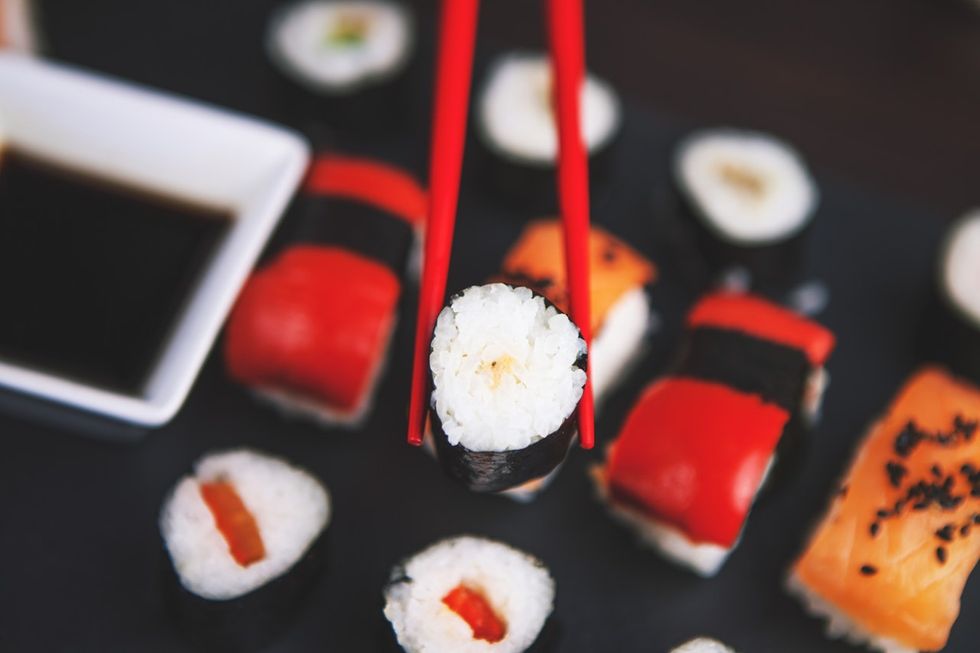Most of us would be surprised that only 25 years ago, most Americans considered sushi to be an exotic delicacy. The simple combination of rice and raw fish the realm of the adventurous, curious, or the rich looking to impress. Today, sushi joints are almost as numerous as coffee shops. From the cheap conveyor belt sushi restaurants to the high-end ones with world-renowned chefs. But even if you consider yourself a true sushi fanatic, we are quite positive there are a couple of things you never knew about this Japanese food.
1. People used to never eat sushi rice.
Back in the 8th century, fermented rice was used to preserve the fish in Southeast Asia. A whole fish would be salted and covered in fermented rice. The rice stopped the fish from spoiling and would get thrown away before eating. As the fermentation time decreased over the years, people started to eat the rice together with the fish.
2. Sushi was originally a cheap fast food.
During the early 1800s, sushi was Tokyo's fast food. The fish was lightly cooked or marinated in soy sauce to keep it from spoiling and these cheap sushi stands were everywhere. Later on, because of the food standards, the government outlawed them, forcing chefs to instead open up their own restaurants.
3. ‘Inside-Out Rolls’ aren’t a thing in Japan.
In America, most sushi rolls these days are "inside-out". Meaning that the rice is on the outside with the nori on the inside. The inside-out roll was created by Ichiro Marashita specifically for Americans who were grossed out seeing the nori on the outside. In Japan, most rolls are made with nori on the outside, sushi rice, and finally the fish in the center.
4. The wasabi you are eating...isn't wasabi.
Turns out that real wasabi is not only difficult to grow but also expensive. So in order to mass produce 'wasabi' sushi restaurants use horseradish and mustard powder with green food coloring.
5. Most ‘sushi’ as we know it is actually maki or nigiri.
There are many different varieties of sushi such as temaki (a cone-shaped hand roll), chirashi (a bowl of rice with fish on top), and oshi (cured or cooked fish and rice that's pressed into a square shape). When most of us picture sushi, we usually think of maki, fish rolled in rice and nori and sliced, or nigiri, a slice of raw fish over rice. Of course, there is also sashimi, sliced thin pieces of raw fish or shellfish.
6. You’re supposed to use your fingers.
Chopsticks are supposed to be only used for sashimi. All the other sushi varieties are supposed to be eaten with your fingers and in one bite.
7. It takes years to perfect nigiri rice.
It takes a long time to master making the perfect nigiri rice. The rice gets mixed with vinegar using a wooden paddle. Not only is it supposed to be at body temperature but also sticky enough to not fall apart as you pick it up to eat it. However, at the same time, it also needs to separate into individual grains once it's in your mouth. To accomplish this seemingly impossible feat, a perfectly precise amount of pressure needs to be applied to make the outer layer more densely packed than the inside.
8. Even fresh sushi is frozen prior to serving.
The FDA requires all sushi to be frozen for at least 24 hours prior to serving in order to kill parasites. Conducted taste tests showed that this didn't have an impact on the final product or taste, but not everyone agrees. Today there are even some sushi restaurants in Japan that freeze their fish.
9. Salmon sushi wasn’t invented until the 1980s.
This makes sense since salmon isn't native to Japan. The Norwegians first brought it over in the early 80s and that's when it was used in sushi for the first time. Which is great because not only does salmon taste amazing, as most of us already know, it's rich in omega-3 fatty acids. Omega-3 has many health benefits and has even been linked to helping with high blood pressure.
10. Most of us improperly dip our sushi.
When dipping sushi into soy sauce, you're not supposed to sink it. You've probably noticed that it starts to fall apart after. To eat sushi properly, the soy sauce needs to only touch the fish. The rice absorbs too much of the soy sauce and this changes the delicate balance of the taste. Apparently, chefs in high-end Japanese sushi restaurants will get offended if they see you do this. Something to keep in mind if you're planning a trip to Japan in the near future.




 Energetic dance performance under the spotlight.
Energetic dance performance under the spotlight. Taylor Swift in a purple coat, captivating the crowd on stage.
Taylor Swift in a purple coat, captivating the crowd on stage. Taylor Swift shines on stage in a sparkling outfit and boots.
Taylor Swift shines on stage in a sparkling outfit and boots. Taylor Swift and Phoebe Bridgers sharing a joyful duet on stage.
Taylor Swift and Phoebe Bridgers sharing a joyful duet on stage.













